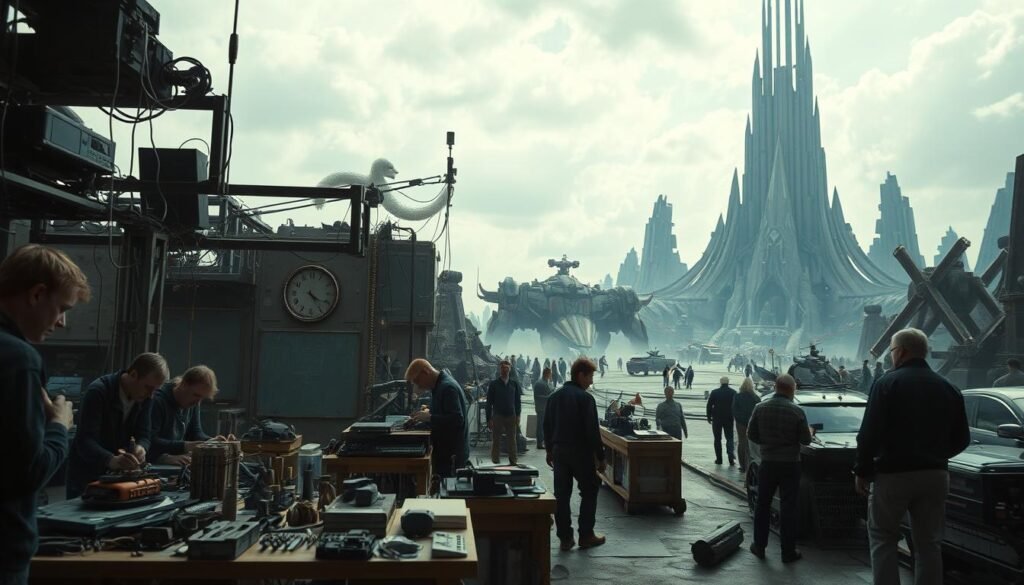Nearly 130 years ago, Georges Méliès used a simple camera trick to bend time. Today, movies use a mix of skill and new tech: visual effects. They have grown from simple tricks to huge CGI systems that tell big stories.
We follow a path from Méliès’ early tricks to the big films of the mid-20th century. This path shows how VFX became key to telling stories on screen. It’s a tool that turns ideas into amazing sights.
We want to share this journey with engineers, students, and teachers. We’ll show how new tech and creativity built today’s digital effects. We’ll also talk about important films and companies like Industrial Light & Magic that made CGI look real.
This section introduces why VFX is important, its evolution, and lessons for the future. For more info or to work together, email us at info@digiverse.studio.
Introduction to Visual Effects
Visual effects connect our dreams with the real world. Filmmakers mix practical and digital effects to create images that don’t exist in raw footage. This blend helps tell stories and pushes what’s possible in productions.
We explore both the art and science behind bringing scenes to life. VFX includes many methods, from stop-motion to CGI. Motion graphics add to these, making titles and explanations more engaging.
Learning about VFX history is key. Early cinema tricks by Méliès and the Lumière brothers started it all. Their work shows how tricking the eye evolved into a mix of engineering and creativity.
What Are Visual Effects?
Visual effects change or create images beyond what the camera captures. Practical methods like rigs and prosthetics meet digital ones like compositing. This mix lets directors create scenes that are too risky, expensive, or impossible to film.
The VFX process is like a pipeline: from planning to final compositing. Each step needs different skills and teamwork. This ensures a smooth production and post-production process.
The Importance of Visual Effects in Filmmaking
Visual effects set the tone for genres. Science fiction and fantasy use CGI to build worlds. Action and horror mix practical and digital effects for realism or drama.
Motion graphics add clarity to complex scenes and enhance branding. Early VFX planning helps avoid budget and schedule problems. Finding the right mix of effects improves both creativity and efficiency.
| Aspect | Primary Benefit | Typical Techniques |
|---|---|---|
| World Building | Enables immersive environments | CGI landscapes, matte painting, set extensions |
| Character Effects | Creates beings beyond physical limits | Prosthetics, performance capture, creature rigging |
| Action & Stunts | Increases safety and spectacle | Practical rigs, wirework, digital cleanup |
| Explanatory Visuals | Clarifies concepts for audiences | Motion graphics, diagrams, 3D overlays |
| Budget & Schedule | Optimizes cost vs. creative needs | Previsualization, hybrid practical/digital planning |
The Early Days of Visual Effects
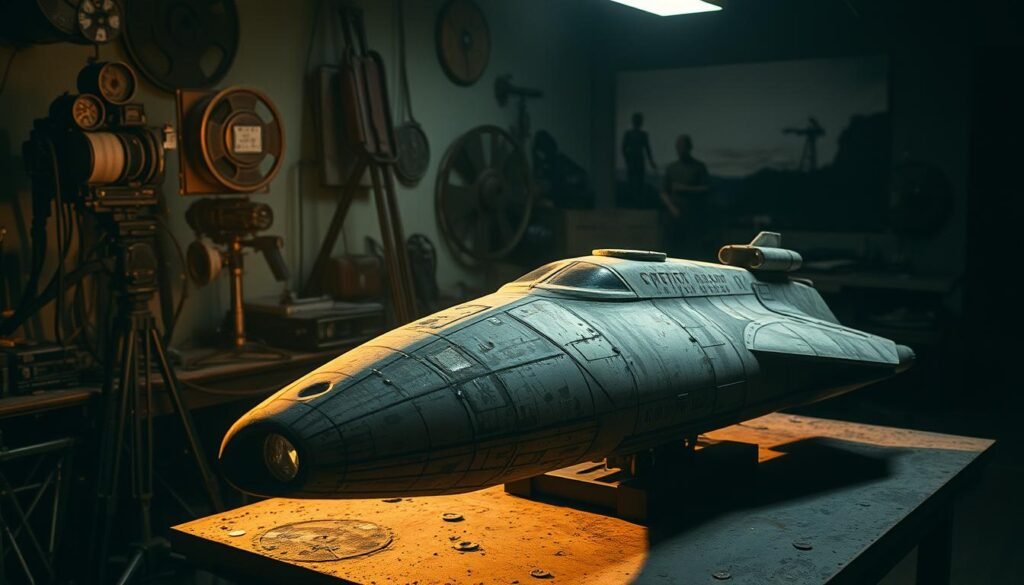
Filmmakers started by using their hands to create illusions. They played with film stock and camera parts. This early work is the foundation of what we learn and teach today.
The Birth of Practical Effects
Georges Méliès was a pioneer. He used camera tricks like stops, double exposure, and time-lapse in A Trip to the Moon (1902). These tricks grew into a set of practical effects, including forced perspective and stop-motion.
Technicians mixed mechanics and optics. They used precise rigging and lenses to make illusions look real. These skills are key in today’s VFX labs.
Iconic Films Featuring Early Effects
Old movies used matte painting and scale models to tell stories. The Wizard of Oz (1939) mixed painting and sets for dreamlike scenes.
King Kong (1933) combined stop-motion with miniatures and rear projection. This created a believable giant ape. Later, Stanley Kubrick’s 2001: A Space Odyssey (1968) used models and photography to show space in a new way.
These films set high standards for special effects. Instead of being outdated, old methods blend with new digital tools.
The Rise of Special Effects in Cinema
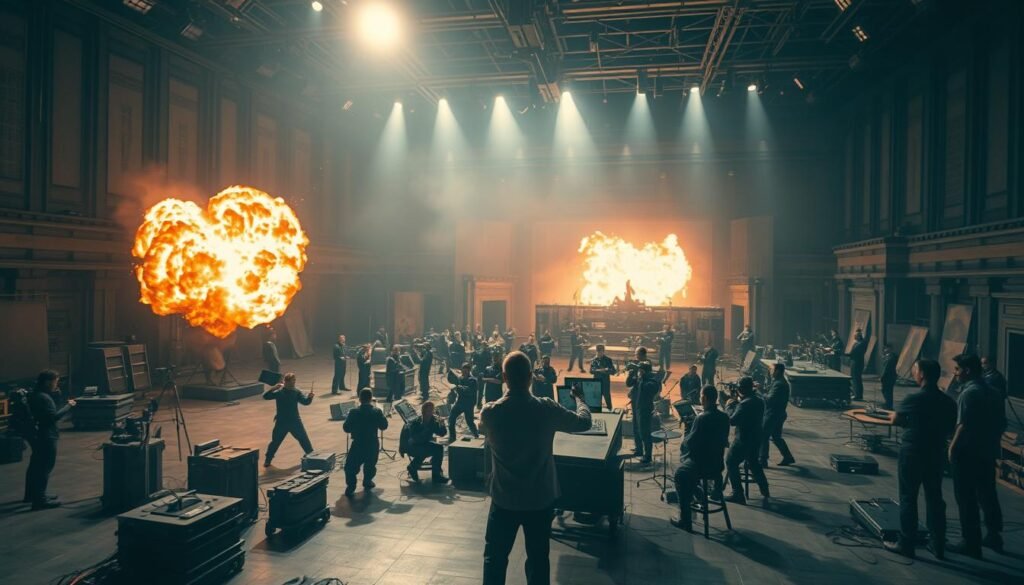
Special effects evolved from small craft shops to big tech studios. Filmmakers combined art and engineering to solve visual challenges. This blend created techniques that shape today’s film industry.
Techniques That Changed the Game
Matte paintings extended sets and saved money. They kept the visual scope big. Rear projection let directors place actors in distant locations without leaving the set. This kept lighting and exposure consistent.
Stop-motion and miniature work brought creatures and vehicles to life in early movies. Optical effects, like layered film exposures and compositing, allowed multiple elements in one frame. These effects were key in studio workflows for years.
Motion-control rigs brought precise, repeatable camera moves. This made complex compositing possible and paved the way for digital work. Engineers and students can learn a lot from these mechanical systems about synchronization and tolerance control.
Influential Filmmakers Pioneering Special Effects
Georges Méliès was a pioneer of cinematic trickery with in-camera edits and model work. Stanley Kubrick pushed the limits of practical illusion in 2001: A Space Odyssey. Ridley Scott brought atmospheric and material realism to films like Alien.
George Lucas changed the game by founding Industrial Light & Magic after Star Wars. ILM made motion-control photography and layered compositing standard in big productions. This team combined inventive engineers with creative directors to make effects for the masses.
Studying these pioneers teaches us about the importance of creative vision and repeatable technique. We suggest studying motion-control systems, photochemical compositing, and historic optical effects. This will help ground modern VFX work in proven engineering principles.
The Transition to Digital Effects
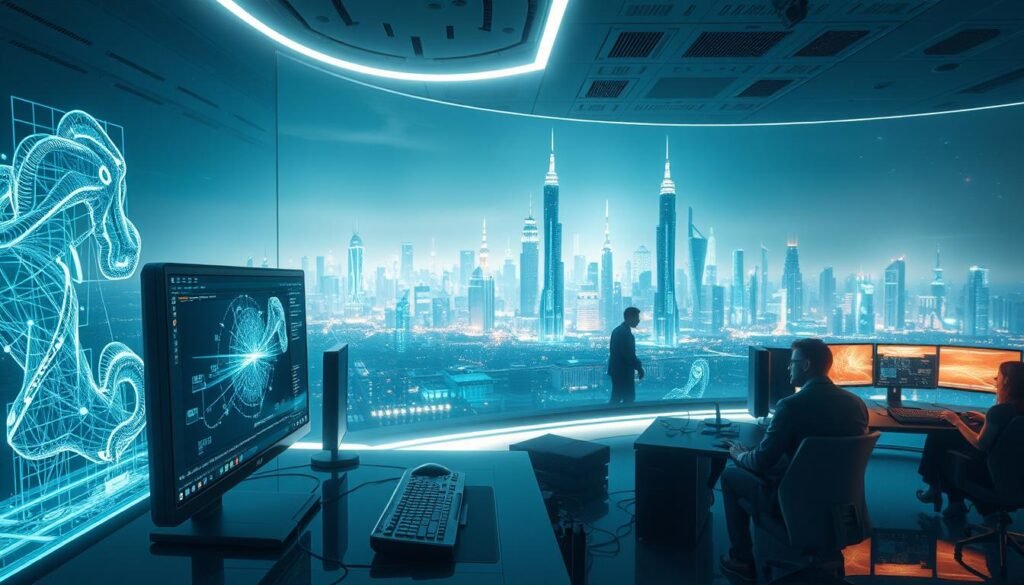
We look at how films moved from practical sets to digital worlds. Early computer graphics started a big change in filmmaking. Studios mixed old techniques with new digital effects to solve problems.
Several key moments are studied by engineering students today. The 1970s and 1980s saw the start of computer-generated imagery. This brought new tools like digital compositing and early rendering routines.
The Advent of CGI
The 1990s saw a big leap: CGI became a main part of filmmaking. Terminator 2 showed how 3D effects could make characters seem real. Studios used computers to create scenes that needed big practical setups before.
Jurassic Park showed that digital creatures could look real with live actors. It mixed animatronics with CGI to make dinosaurs seem real. This made directors and producers believe in digital effects for movies.
Key Milestones in Digital Visual Effects
There have been many technical milestones in VFX. These include better rendering algorithms and motion capture systems. Each step made digital images look more real.
- 1960s–1970s: foundational experiments in raster graphics and motion control.
- 1980s: digital compositing and early 3D models for films like Star Wars spin-offs.
- 1991: Terminator 2 popularized 3D character effects driven by PC pipelines.
- 1993: Jurassic Park proved photoreal CGI could replace or enhance practical creatures.
- 1999–2009: innovations such as camera arrays, motion capture, and performance capture expanded realism.
For engineering students, studying graphics pipelines and rendering algorithms is key. Learning about motion capture hardware is also important. Making digital images fast and cheap is a big challenge.
| Milestone | Technical Advance | Impact on Production |
|---|---|---|
| Early raster experiments | Basic pixel synthesis and frame buffering | Opened concept of image generation with computers |
| Digital compositing | Layer-based image fusion and keying | Streamlined post-production, more creative control |
| PC-based 3D pipelines | Affordable modeling, texturing, and rendering tools | Democratized access to cinema-quality digital effects |
| Photoreal rendering | Physically based shading and global illumination | Enabled believable surfaces for characters and environments |
| Motion and performance capture | High-fidelity actor tracking and retargeting | Improved performance-driven CGI for believable motion |
Blending Techniques: Practical Meets Digital
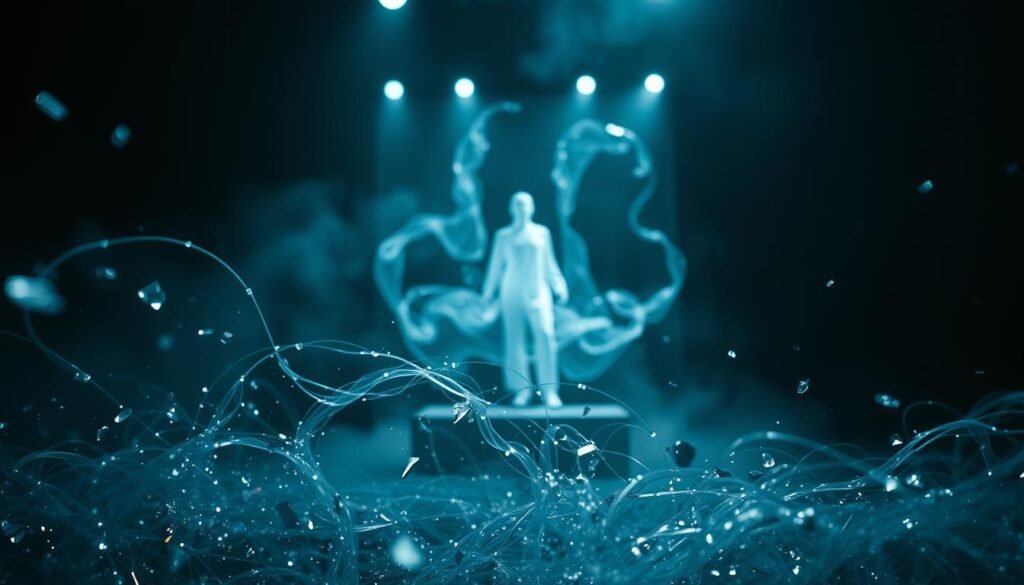
We look at how crafts and digital tools come together on modern sets. This mix starts with real things: prosthetics, miniatures, and animatronics. These help actors feel like they’re in a real world.
Then, digital teams work their magic. They adjust scale, lighting, and motion. This makes the final image look seamless.
Hybrid effects are more than just tricks. They help actors perform better and feel more real. When practical and digital blend, compositors use real textures. This makes CGI look more authentic.
Students and technicians can learn from these methods. Knowing how to make prosthetics and miniatures is key. Working together with digital artists ensures everything looks right.
Hybrid effects in Modern Filmmaking
Jurassic Park showed us how to mix animatronics with CGI. Mad Max: Fury Road used stunts and practical effects, then added digital touches. These films prove that starting with practical effects makes everything better.
Malignant (2021) is a recent example. It used prosthetics and animatronics for creatures. Then, digital artists made the faces look right and removed rigs. The result was believable and a bit spooky.
Case Studies: Successful Film Blends
Directors like George Miller and Christopher Nolan start with practical effects. They add CGI for set extensions and texture. This approach makes the movie feel more real and emotional.
For new artists, learning from these examples is key. Focus on making prosthetics and miniatures well. Record accurate lighting and document lens data. This helps digital artists do their job better.
When teams work together, magic happens. They use shared standards like naming conventions and accurate metadata. This makes the final image better and saves time.
Behind the Scenes: How Visual Effects Are Created
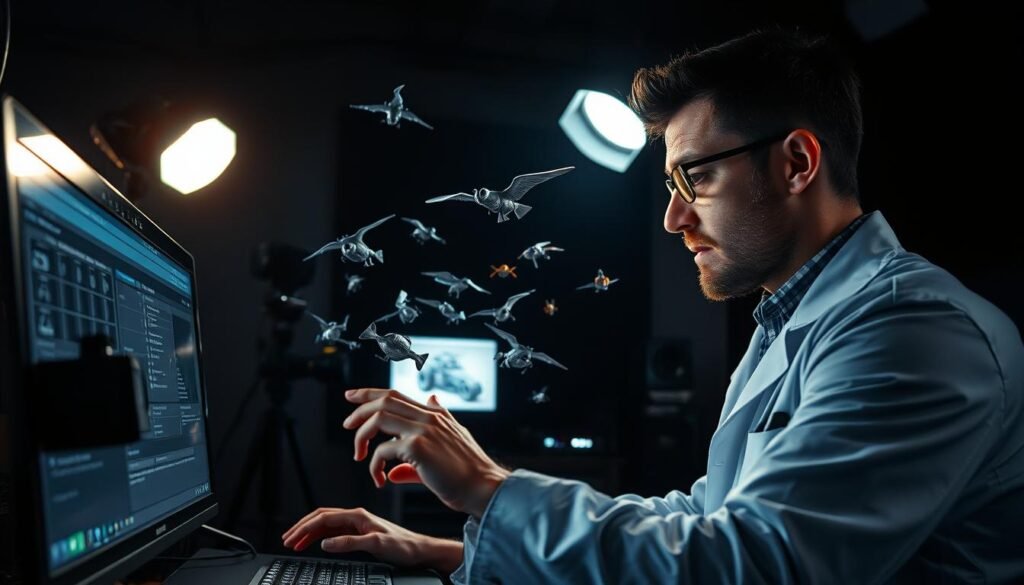
We take you through the steps that turn an idea into a final shot. A visual effects sequence starts with concept and previs. Then, it moves to careful on-set data capture.
Teams collect HDRI, LIDAR scans, and reference plates. This ensures assets match lighting and scale during post-production.
The Creative Process of Visual Effects Production
The creative process is divided into clear phases: concept, asset creation, animation, lighting, and compositing. Previsualization and motion capture let directors see early versions of scenes.
Virtual production with LED volumes and real-time engines like Unreal Engine reduces iteration time on set.
Large sequences need planning: match-moving, rotoscoping, dynamics simulation for fluids or smoke, and physically based rendering. A visual effects artist must blend artistic judgment with technical precision.
This keeps shots believable and consistent.
Tools and Software Used in the Industry
We use industry-standard tools for each stage of the VFX pipeline. Autodesk Maya and Houdini handle modeling, rigging, and simulation. Nuke is a common choice for compositing.
Unreal Engine powers real-time rendering and virtual production workflows.
Major houses like Industrial Light & Magic and Weta Digital use proprietary software alongside these tools. Emerging AI assists with rotoscoping and facial animation, speeding routine tasks.
This frees artists to refine creative choices.
We recommend integrating on-set acquisition with standardized asset pipelines and version control. This improves turnaround and reduces rework during compositing and final rendering.
Clear handoffs in the VFX pipeline help teams scale complex sequences without losing quality.
The Role of Visual Effects Artists
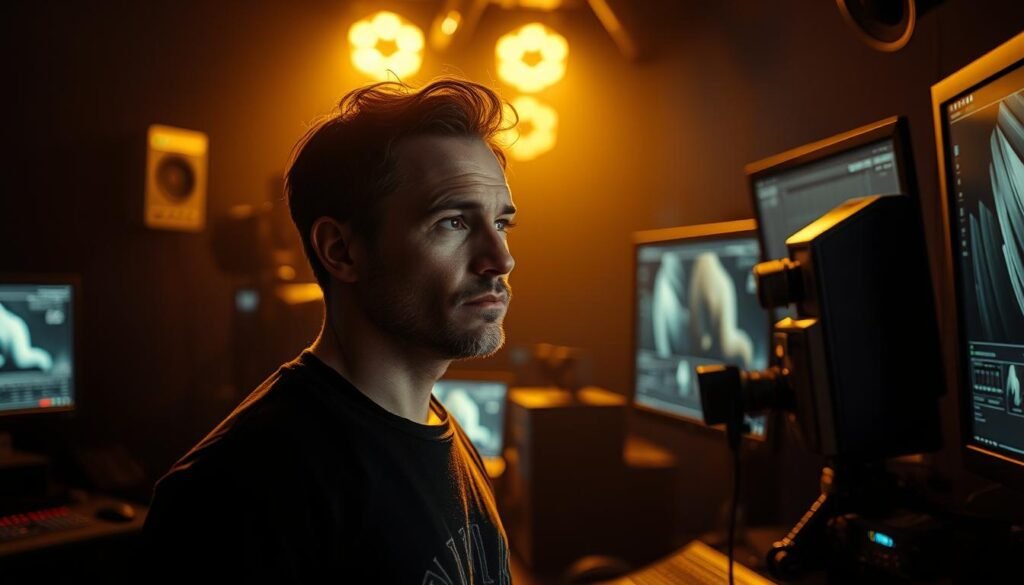
We blend art and engineering to create stunning visuals. Teams of experts work together to make scenes come alive. They use their skills in modeling, animation, and lighting to bring stories to life.
Essential Skills for Visual Effects Artists
Artists need to know 3D math, shading, and lighting well. They also use color theory to match digital images with real ones. Knowing software like Maya and Unreal Engine is key to working fast.
Compositing artists must be good with renderers and compositors. They also need to pay attention to detail when combining different images. Skills in motion capture and motion graphics help make digital characters look real.
Knowing how to script and understand pipeline design is important. It helps make work more efficient and consistent. Being able to solve problems quickly is a must in this fast-paced field.
Notable Visual Effects Professionals
Leaders like Industrial Light & Magic and Weta Digital have set high standards. They’ve shown us what’s possible with visual effects. Dennis Muren and teams behind The Lord of the Rings have inspired many.
Engineers and directors are now key players. They create tools that help artists do their best work. For newcomers, combining art skills with VFX knowledge is the way to go.
Visual Effects in Different Genres
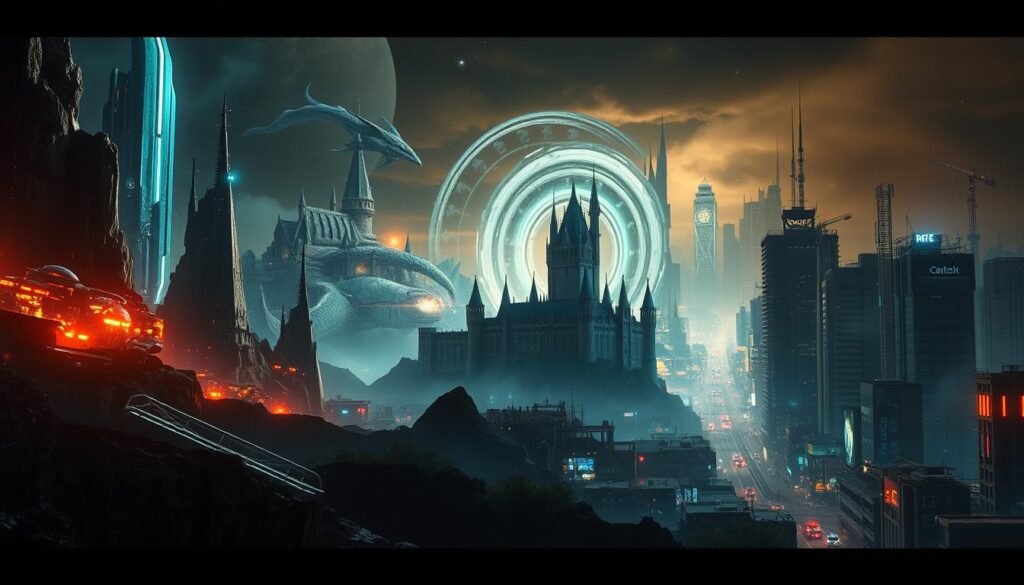
We look at how film genres affect visual effects. Each genre has its own style and purpose. This guides the choice of texture, motion, and tone.
By understanding these styles, students and professionals can better match their skills to the story. This makes the visuals more impactful.
How Genres Influence VFX Styles
Science fiction and fantasy focus on creating worlds and characters. They use CGI to bring creatures and environments to life. Lighting and shading are key to making these worlds believable.
Horror films mix practical effects with digital touches. This creates a more intense experience. The goal is to build tension, not just show off special effects.
Action movies aim for realism and safety. Visual effects help make stunts and destruction look real. This keeps the action believable and safe for the actors.
Comparative Analysis of VFX in Action vs. Fantasy Films
Action VFX focuses on physics and blending with real-world elements. Explosions and car crashes need a mix of practical and CGI work. The goal is to keep the action feeling real.
Fantasy films offer more creative freedom. Artists can explore different styles and motions. This includes unique character designs and magical effects.
| Aspect | Action Films | Fantasy Films |
|---|---|---|
| Main goal | Believability, safety, physical accuracy | Worldbuilding, emotional wonder, creature believability |
| Common tools | Dynamics solvers, rigid body sims, motion capture | Character rigs, hair/fur shaders, volumetric particle systems |
| Typical pipeline focus | Matchmoving, destruction sims, plate integration | Modeling, advanced shading, creature animation |
| Visual priorities | Realistic lighting, accurate motion blur, continuity | Stylized motion, magical effects, distinct silhouettes |
| Training emphasis | Simulation, compositing, on-set safety protocols | Anatomy, rigging, advanced shading and texture work |
| Representative films | Marvel films, Mad Max: Fury Road | Harry Potter series, The Lord of the Rings |
Motion graphics support various genres. They add to the story in science fiction, thrillers, and fantasy. Used well, they enhance the visuals without overpowering the narrative.
Teachers should tailor courses to match genre demands. For action VFX, focus on dynamics and simulation. For fantasy, emphasize CGI, rigging, and shading for creature work.
Innovations Shaping the Future of Visual Effects
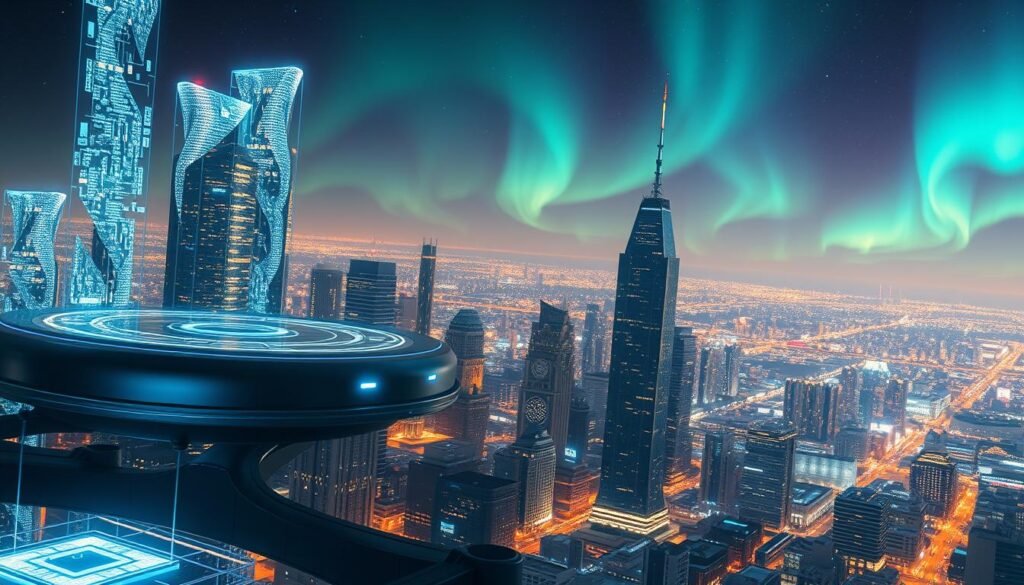
Tools and pipelines are evolving quickly. Real-time rendering and virtual production are becoming common on sets. Studios like Industrial Light & Magic and Epic Games are leading the way.
Emerging Technologies in Visual Effects
Real-time rendering engines let teams see CGI on set. This change cuts down on post-production work and speeds up feedback. Unreal Engine and Unity are key players in these workflows.
AI in VFX makes tasks like rotoscoping and facial animation faster. Machine learning helps automate repetitive tasks, opening up new creative possibilities. But, we need to ensure these tools are used responsibly.
The Impact of Virtual Reality and Augmented Reality
VR and AR change how we tell stories. They let audiences explore scenes, not just watch them. This requires optimized assets and fast rendering.
Education needs to focus on both technical skills and practical experience. Students should learn in real-time engines and mixed-reality environments. This way, they can make informed decisions in real-world scenarios.
Criticism and Challenges of Visual Effects
Modern filmmaking faces many challenges. Tight budgets, packed schedules, and big dreams meet in post-production. These issues test everyone involved, from studios to visual effects artists.
Filmmakers like Christopher Nolan and George Miller prefer practical effects. They help keep performances real. This approach also makes post-production easier.
The debate on VFX overuse is real. Too much CGI can hurt storytelling. Audiences and critics often notice and complain.
Working conditions and sustainability are big concerns now. Long hours and last-minute changes are common. Visual effects artists often feel the pressure.
Practical solutions and hybrid workflows can help. Early planning and realistic expectations are key. Training in project management and ethics is also important.
We suggest clear contracts and steady vendor relationships. Tools that help artists focus on their craft are essential. Small changes can make a big difference.
Education needs to change too. Courses should teach both technical skills and teamwork. When everyone works together, surprises are fewer, and results better.
Conclusion: The Future of Visual Storytelling
We are at a crossroads where art and technology merge. The future of visual effects will mix practical skills with CGI advancements. This will be thanks to real-time rendering, LED volumes, and smoother motion graphics workflows. Our goal is to make the impossible believable, while keeping the story and performance real.
Predictions for the Evolution of Visual Effects
We see virtual production and game-engine use growing fast. AI will take over routine tasks, freeing up time for creativity. Performance-capture and motion-capture will get better, keeping the actor’s essence even with digital doubles.
The Ongoing Importance of Visual Effects in Cinema
Leaders like Industrial Light & Magic and Weta Digital show a path of balance. They mix practical effects with CGI, making stories more real. This mix keeps the emotional truth and technical magic alive in films.
We encourage educators, engineers, and creators to learn together. Blend computer graphics, optics, mechanics, and storytelling. If you want to talk about teaching, research, or production, email us at info@digiverse.studio. Let’s work together to advance VFX and enhance cinematic dreams.

